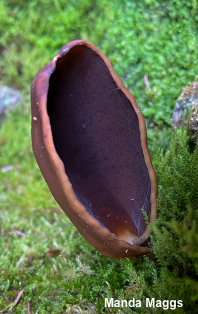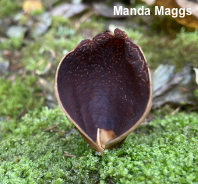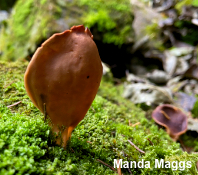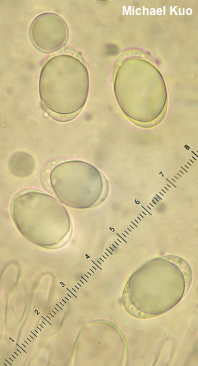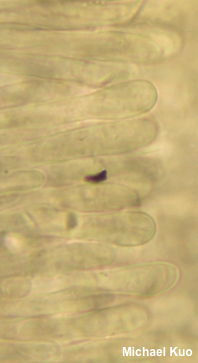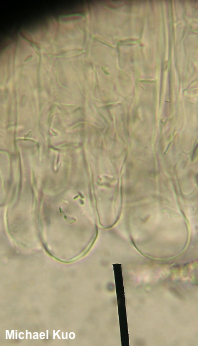| Major Groups > Cup Fungi > Helvella silvicola |

|
[ Ascomycota > Pezizales > Helvellaceae > Helvella . . . ] Helvella silvicola by Michael Kuo, 8 December 2022 Is there a little donkey buried under there, with just his ears sticking out? This funky cup fungus, found under conifers in northern and montane regions of North America and Europe, is reminiscent of rounded-off donkey ears poking up through the duff. The inner surface is dark brown, often with purplish or reddish hues, and the outer surface is paler brown. There is a short, yellowish to whitish stem, usually buried in the duff. Species of Otidea can be similarly folded inward and ear-reminiscent, but only a few of them are similarly colored; these can be separated easily under the microscope, since they have "hooked" or curved paraphyses, and spores with two or more small oil droplets. Synonyms are numerous, and include Wynnella silvicola, Otidea auricula (in the sense of some authors), and Midotis lingua. I think the best name for the fungus would be "Helvella lingua," but that combination has not been published. See the discussion below if any of this matters to you. Thanks to Manda Maggs for documenting, collecting, and preserving Helvella silvicola for study; her collection is deposited in The Herbarium of Michael Kuo. Description: Ecology: Possibly mycorrhizal; growing alone, scattered, or gregariously under conifers; summer and fall. Originally described from Sweden (Fries 1828) and neotypified (Hansen et al. 2019) from Switzerland; in Europe found mostly in northern and montane areas; in North America found from roughly the 43rd parallel northward, as well as in the Rocky Mountains and montane Mexico. The illustrated and described collection is from British Columbia. Fruiting Body: 2–8 cm high; 1–2 cm wide; shaped like a rounded-off donkey ear (like a cup fungus folded inward along a vertical axis); outer surface medium brown and bald, becoming more pale toward the base; inner surface dark purplish brown to dark reddish brown, bald; base with a rudimentary, wrinkled or ribbed stem, up to about 2 cm long and 1 cm thick, with a yellowish to pale brownish or whitish surface. Flesh: Thin; brittle; brownish in the "ear" and whitish in the stem; unchanging when sliced. Odor: Not distinctive. Microscopic Features: Spores 18–23 x 13–15 µm; broadly ellipsoid; smooth; with one large central oil droplet that often nearly completely fills the spore; hyaline in KOH. Asci 275–300 x 10–12.5; 8-spored; hyaline in KOH. Paraphyses exceeding the asci by 10–12 µm; filiform with rounded to clavate or subclavate apices; 3.5–5 µm wide at the widest point; hyaline in KOH. Excipular surface trichoderm-like, with clavate, septate elements 10–15 µm wide, smooth, hyaline to, en masse, brown in KOH. Hyphae of the contest densely interwoven; 3–4 µm wide; smooth; hyaline in KOH. REFERENCES: (J. A. F. Nannfeldt, 1966) H. Harmaja, 1974. (Kanouse, 1949; Abbott & Currah, 1997; McNeil, 2006; Parslow & Spooner, 2009; van Vooren, 2013; Beug et al., 2014; Landeros et al., 2015; Skrede et al., 2017; Hansen et al., 2019; Læssøe & Petersen, 2019; Wang et al., 2019.) Herb. Kuo 10232201. Discussion: The most current name for the fungus described on this webpage is Midotis lingua. Hansen and collaborators (2019) suggest breaking up the genus Helvella into the following: a more limited Helvella; a single-species genus, Pindara, for Helvella terrestris; a new genus, Dissingia, for Helvella leucomelaena and closely related species; and Midotis, a resuscitated genus name, for Helvella silvicola and one other species. The authors' proposal is based on a 3-gene phylogeny that parallels other molecular phylogenies (Landeros et al. 2015, Skrede et al. 2017, Wang et al. 2019); in these phylogenies the same clades appear in the same positions, with Helvella silvicola as sister to the remaining clades, the Helvella leucomelaena group sister to what remains after that, and Helvella terrestris sister to the remainder of Helvella. Following contemporary guidelines for the establishment of new genera (Vellinga et al. 2016), Hansen and collaborators attempt to provide a discussion of options supported by their results. They begin with:
This sentence should be read several times because, ultimately, it is incoherent; the sentence says the results represent two possibilities, then apparently changes its mind and says that only the second option is supported by the results. The authors were right the first time: the molecular results support either a large Helvella, or a series of sister genera. In either case the rule of monophyly is upheld, and nothing is placed among things it is not related to. A potentially stronger argument for multiple genera comes in the form of the authors' suggestion that the molecular results, when combined with morphological differences between the groups, support breaking Helvella up into segregate genera. Ascus development is the morphological feature the authors propose as support to accompany the molecular results; in some of the proposed genera the asci are "aporhynchous" (arising from croziers), and in others the asci are "pleurorhynchous" (arising from simple septa). The problem is, ascus development in the proposed genera does not parallel the molecular results. One group within the restricted Helvella (the Helvella corium group) is aporhynchous, as is Dissingia, but everything else is pleurorhynchous—leaving ascus development as a variable, non-monophyletic character, representative of convergent evolution. For me, expression of evolution is the most important factor when making taxonomic choices like this. As I've argued elsewhere (Kuo & Ortiz-Santana 2020), a "shared genus name enables nonspecialists to recognize the closely shared evolution of the taxa." Unless one is a Helvellologist (say that three times fast) familiar with all these genus names, one is not going to know that Dissingia leucomelaena is closely related to Helvella crispa. Thus I prefer to maintain the genus Helvella in a wide sense, supported by monophyly of molecular results and allowing for variability in ascus development and other morphological features. Hansen and collaborators also suggest that the best species name for Helvella silvicola may be lingua, based on Fries's 1825 description of Midotis lingua. I agree with this assessment; the only other contender would be Wynnella subalpina, described from China (Zhao et al. 2016), with slightly different colors and narrower spores. However I'm unable to use the name "Helvella lingua," which would be the most appropriate for my purposes, because that combination has never been published in the nomenclatural record. This site contains no information about the edibility or toxicity of mushrooms. |
© MushroomExpert.Com |
|
Cite this page as: Kuo, M. (2022, December). Helvella silvicola. Retrieved from the MushroomExpert.Com Web site: http://www.mushroomexpert.com/helvella_silvicola.html |
